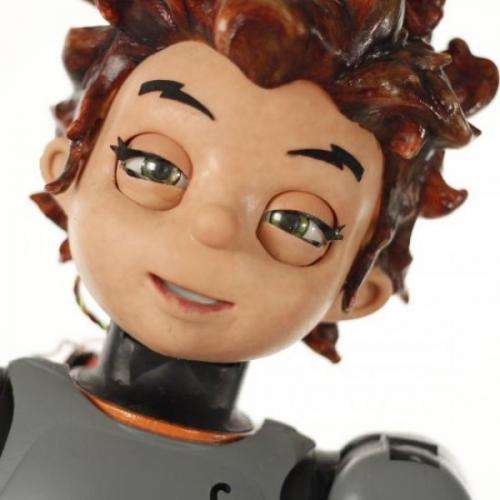August 4, 2012 weblog
Zeno "boy" robot: Let me introduce myself (w/ Video)

(Phys.org) -- Hanson Robotics is showing its new humanoid robot boy that belongs in its Robokind portfolio of robots, a 2012 reincarnation of its earlier cartoonlike Zeno boy but this time more humanoid with an array of gestures and eye movements. Made in China, the boy-like robot stands 27 inches tall. The most commanding feature of the new Zeno is its head, made out of what creator David Hanson calls Frubber. The material, as the word sound suggests in melding flesh with rubber, is a spongy, structured elastic polymer that can mimic facial movements, contracting and folding like human skin. The material is also described as biomimetic polymer.
Also contributing to its lifelike quality are its eye expressions and moving eyelids. Hanson has given the robot's eyes a pair of high-definition cameras for facial recognition. The body has 37 degrees of movement, the most of a Hanson robot so far.
The “boy” was designed with an open source platform; the robot has an internal computer and advanced artificial intelligence. “As soon as possible,” according to Hanson, ”we will release a complete SDK for software development on any Robokind platform.”
The robot introduces itself in an engaging presentation video, designed to engage investors to help Hanson bring it to market. It says that “I can provide autism therapy,” and it tells the world that it can also give courses.
The robot also makes a few announcements of company developments. Its sister Alice will soon be available, and, most notably, the new robot will be joined by a smaller crop of smaller robot “cousins” that will be less expensive. “I look forward to meeting them in a about a year,” says the robot in the video.
Observers note that such smaller cousins will be the way that the company can break into a wider mass market than can presently accommodate the high prices of Hanson’s high-end robots priced from $8500 to $14,750 and targeted for special robotics and psychology research. This price range represents different models of robots with different capabilities depending on what their research clients need—robots that can move but have expressionless faces, robots with expressive faces that cannot move, or robots that can do both.
For those who subscribe to the “uncanny” theory of human-like robots being disturbingly like their human companions, Hanson thinks otherwise and has founded his company’s future on the belief that humanoid robots will increasingly occupy a place in science.
He said humanoid robots cross-pollinate among the sciences, pushing boundaries of biology, cognitive science, and engineering. “We work to bring neuroscience, robotics, and the arts into a super-discipline of humanlike cognitive robotics.”
More information: hansonrobokind.com/the-robot/overview/
via IEEE
© 2012 Phys.org





















